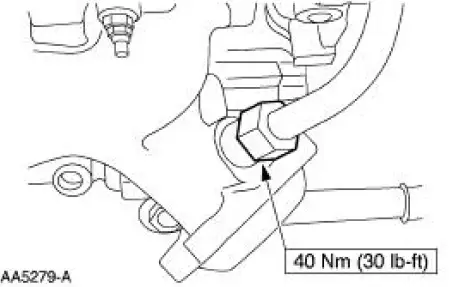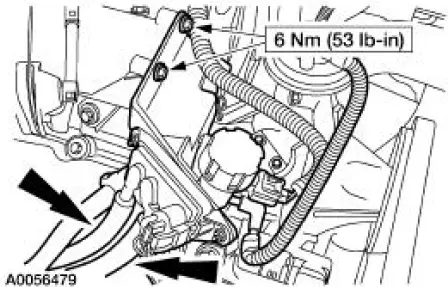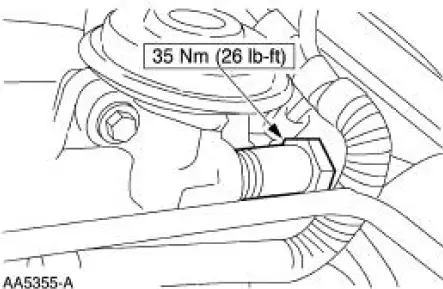Ford Mustang (1999-2004) Service Manual: Exhaust Manifold to Exhaust Gas Recirculation (EGR) Valve Tube
Removal and Installation
NOTE: 3.8L shown, 4.6L (2V) similar.
1. With the vehicle in NEUTRAL, position it on a hoist.
2. Disconnect the exhaust gas recirculation (EGR) valve tube from the exhaust manifold.

3. Remove the differential feedback exhaust gas recirculation (EGR) system vacuum hoses and the bracket bolts. Position the bracket assembly aside.

4. Disconnect the EGR tube from the EGR valve.

5. Remove the exhaust manifold-to-EGR valve tube.
6. To install, reverse the removal procedure.
 Exhaust Gas Recirculation (EGR) Valve - Mach I
Exhaust Gas Recirculation (EGR) Valve - Mach I
Removal and Installation
1. Remove the air intake scoop. For additional information, refer to
Section.
2. Remove the exhaust gas recirculation (EGR) valve.
1. Disconnect the EGR tube upper fi ...
 Exhaust Manifold to Exhaust Gas Recirculation (EGR)
Valve Tube - Cobra
Exhaust Manifold to Exhaust Gas Recirculation (EGR)
Valve Tube - Cobra
Removal and Installation
1. Remove the EGR valve. For addditional information, refer to Exhaust
Gas Recirculation (EGR)
Valve-Cobra in this section.
2. With the vehicle in NEUTRAL, position it on ...
Other materials:
Fuel Charging And Controls
The fuel injection supply manifold (9F792):
delivers fuel to the fuel injector.
receives fuel from the fuel supply line.
The throttle body (9E926):
controls air supply to the upper intake manifold (9424) by positioning
the throttle plate.
connects the ...
Engine - 4.6L (2V)
General Specifications
a - With installation of a new filter.
b - Distance front edge of bearing is installed below front face of cylinder
block.
c - Time necessary for plunger to leak down 1.6 mm of travel with 222 N force
and leak down fluid in
tap ...
Wipers and Washers (Diagnosis and Testing)
Refer to Wiring Diagrams Cell 59 , Generic Electronic Module for
schematic and connector
information.
Refer to Wiring Diagrams Cell 81 , Interval Wiper/Washer for schematic
and connector information.
Special Tool(s)
Alternator, Regulato ...
